Delta plain, upper
| Sandstone Depositional Environments | |
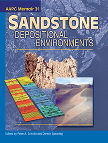
| |
| Series | Memoir |
|---|---|
| Chapter | Deltaic environments of deposition |
| Author | J. M. Coleman and D. B. Prior |
| Link | Web page |
| PDF file (requires access) | |
| Store | AAPG Store |
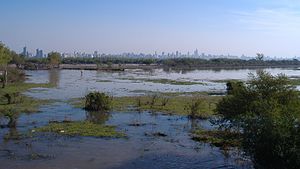
The upper delta plain lies above the level of effective saltwater intrusion and is unaffected by marine processes. Most of the sediments comprising this part of the delta plain originate from the migratory tendency of distributary channels, overbank flooding during annual highwater periods, and periodic breaks in the river banks, in which "crevassing" into adjacent lake basins occurs. The major environments of deposition include braided channels, meandering channels (point bars and meander-belt deposits), lacustrine delta fill, backswamps, and flood plains (swamps, marshes, and freshwater lakes).
Braided-channel deposits
Braided channels are marked by successive divisions and rejoinings of the flow around alluvial islands. Most braided river channels are characterized by a dominant bedload transport of sediment, high variations in water discharge, high downstream gradients, and large width-depth ratio of channels. Most braided rivers display rapid and continuous shifting of sediment and position of channels. These channels are found in all climate zones, but, because of their dependence on erratic discharge and high bedload, they are most common in arid and arctic settings. Braiding characteristics of the channel often extend all the way into the delta plain. However, one of the largest braided channels in the world, the Brahmaputra River, has formed in a humid climatic setting. Lateral migration of channels can be dramatic, as in the Brahmaputra River, where lateral migration rates of several thousand meters during a single flood are not uncommon.[1] In the Rosi River (a tributary of the Ganges River), lateral migration of the channel over the past two centuries has been about 170 km; in a single year the channel may shift over 30 km laterally.[2] Because of high lateral migration rates and shallow depths of scour, most braided-channel deposits display high lateral continuity but are rather thin (rarely over 30 m thick).
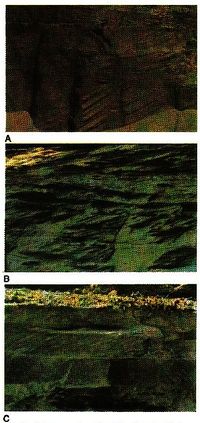
Individual channels split around numerous mid-channel islands or braid bars. During floods erosion occurs on the upstream ends and lateral sides of bars and eroded material is added to the downstream side of the bar. Because each channel has a different depth, lateral migration of the channel results in scour to differing depths. Multiple fining-upward cycles (which are commonly truncated) occur within the resulting sand body. Each fining-upward cycle (owing to deposition of a laterally migrating channel) is characterized by a scoured base and overlying sets of large-scale cross-bedding in which individual sets are up to 1 m thick (Figure1A). This lower sequence of large-scale cross-bedding can attain thicknesses of up to 7 m. Small-scale ripple bedding, scour and fill structures, organic trash, and clay layers are occasionally found.
Overlying this unit is a zone displaying finer grain size and composed of lenticular-shaped units of large-scale cross-bedding (trough type) intercalated with zones of climbing ripple laminations, horizontal laminations, and ripple cross-bedding (Figure 1B). In some places small-scale laminations are present within certain zones. The uppermost unit of the fining-upward cycle displays horizontal laminations separating well-defined, near-horizontal sets of steeply dipping ripple-drift bedding (Figure 1C). Small-scale convolute laminations and burrowed sand and silt layers are common in the uppermost part of the unit. However, scouring by later migration of the channel often removes this upper burrowed section.
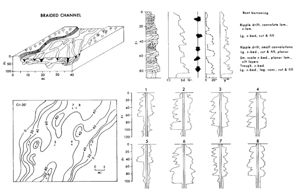
Figure 2 summarizes the major characteristics of braided-channel deposits, including lateral relationships (block diagram in upper left); typical vertical sequence (upper right), including grain size, directional properties, dip angles, relative porosity, and sedimentary structures; sand body isopach map (lower left); and representative electric logs (lower right) at selected sites to show variation in log shape. As this diagram illustrates, the typical vertical sequence is characterized by multiple stacked fining-upward cycles of deposition (each representing deposition by a migratory channel). Directional properties within each cycle often display narrow directional spread and are fairly representative of the long-axis orientation or downstream direction of the channel. High dip angles are most often associated with large-scale cross-bedding and distorted layers.
The isopach map shows a laterally continuous sand body, often extending 20-50 km laterally in a direction perpendicular to the downslope channel direction. Most braided channels display rather uniform thicknesses across the entire sand body (averaging 15 to 25 m thick) and localized deeper sand-filled scoured pods. Log response often shows an overall blocky shape, with numerous sharp "kickouts" representing local coarse-sand-filled scours. Locally numerous fining-upward cycles can be well defined on the logs. Although distinctive cycles can often be discerned from log data, it is very likely that individual units cannot be carried laterally any great distance, and presence of the numerous thin silt and clay layers discourages thinking that reservoir continuity may extend for great dis ances. Exposures in some of the tar sands in Canada show a lack of reservoir continuity as tars are concentrated along distinct layers within the overall sand body. Potential for porosity traps is great in the braided-channel environment.
Faunal remains are rare in braided-channel deposits, but locally freshwater pelecypod and gastropod shells are present. Ostracodes are sometimes encountered in the thin clay zones. Plant remains and root burrows are common in temperate and tropical areas and normally are associated with the top-most unit of a depositional cycle. Leaf impressions are found along bedding planes in the silts and clays, and large logs and other organic trash are present near the lower basal scour. Early diagenic inclusions are normally rare, but calcium carbonate nodules and iron oxide pellets are found in braided channels in the arid environment.
Meandering-channel deposits
A meandering river is one with a channel pattern that displays high sinuosity in plan view (sinuosity greater than 1.5). Meanders are most commonly associated with rivers displaying nonerratic flooding characteristics, high suspended-sediment load (generally fine-grained bedload), and low downslope gradient. Most meandering rivers occur in tropical and temperate climates, where suspended loads and high annual flooding are common, but they will also occur in arctic and arid climates.
Meandering rivers are most common in alluvial valleys of river systems, but in several modern river deltas meandering sections of the distributaries are present, especially in rivers where distributaries are influenced by high tidal ranges or in rivers carrying extremely large coarse bedload sediment.
The channel profile normally displays an asymmetric V shape, the steep cutting bank is referred to as the cut bank; the shallow-sloping depositing side is termed the point bar. Maximum flow velocities are found near the steep concave bank, while lower velocities are present along the point-bar side of the channel. Undercutting of the cut-bank side of the channel during a flood causes oversteepening and slumping of the channel wall. Locally, where the channel scours into sandy deposits, high flood levels (excessive hydraulic head) force river water into the buried sand body. A sudden drop in the river level results in excess pore-water pressure in the buried sand, and water and sand flow back into the river, causing slumping in the overlying bank deposits. In either case, the slumping results in an increase of the channel's cross-sectional area, thereby reducing velocity and causing deposition on the point-bar side of the channel.
Although numerous other processes are active, slumping on the cut-bank side and deposition on the point bar cause channel migration, and continued repetition of this process results in formation of a point-bar or meander-belt sand deposit. In most places, meander-belt deposits fail to migrate entirely across a valley, instead forming finite-width features whose dimensions are narrow compared to the sand-body length. The width of the meander-belt deposit is dependent on the discharge and channel depth. In the lower Mississippi River the channel depth averages 50 m (hence average sand body thickness is 50 m) and the meander-belt width averages 16 km; river depth in the Niger River is 10-15 m and meander-belt width is 10 km; the Sabine River (Louisiana-Texas) is 6-8 m deep and the meande belt is 5-6 km wide.
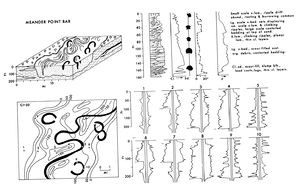
The channel abandoned when a river switches its course to another site is most commonly filled with silty clays, organic clays, and organic trash. The clay-filled channel, therefore, results in numerous nearly isolated sand bodies in the overall meander belt providing innumerable stratigraphic trapping possibilities. This is illustrated in the upper left diagram of Figure 4. The vertical sequence in the meander point-bar sand body is illustrated in the upper right diagram of Figure 3.
Most commonly, the vertical sequence shows a fining-upward grain size relationship; a few coarser layers are found near the upper one-third of the sand body. The sand body has a scoured base, and often coarse, organic trash (logs, limbs and clay clasts) is found intercalated with the sandy units. Thin clay and silt layers often separate coarse sandy units. Above this basal unit is normally a massive, thick sand unit displaying large-scale cross-bedding with occasional contorted layers and thin laminations of organic debris. The large-scale bedforms migrate primarily during periods of high flood.
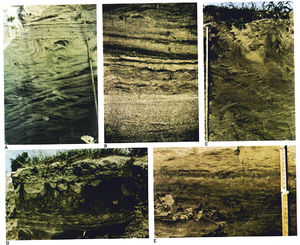
Overlying the large-scale cross-bedding is a well-sorted sand sequence composed of repeated cyclic sedimentation units of climbing ripples, convolute laminations, and parallel well-sorted sand laminations (Figure 4A). Each of the cyclic units represents deposition during a single flood and a change from lower flow to upper flow regime. Such units range in thickness from 0.5 to over 1.5 m. In some areas the flood deposit is poorly sorted and consists primarily of silts and sands displaying small-scale ripple laminations (Figure 4B).
During times of extremely high flooding, rapid deposition often takes place on the point bar because of river currents cutting across the meander loop, attempting to shorten its course. In those instances, thick sequences of rapidly deposited, well-developed climbing ripples capped by contorted laminations are common (Figure 4C). Deposition of 1 to 2 m can take place over only a few hours to a day. Most commonly the distorted bedding simply caps the sand unit, but the entire bed can be rendered into a fluid state and massive contortions can be present (Figure 4D). The zone of maximum contorted bedding often closely approximate the low-water river level and extends upward into the zone covered by flood waters. The uppermost unit of the meander point bar often consists of silt and sand beds (few centimeters thick) displaying ripple laminations alternating with silty-clay and clay beds exhibiting root burrows (Figure 4E). In these uppermost units iron oxide and calcium carbonate nodules usually are abundant.
Sand bodies display wide variations in current directional properties, primarily because of the sinuous nature of the channel and its migrational variations. This is especially true in units consisting of large-scale cross-bedding. The upper climbing-ripple part of the deposit shows much less scatter in directional properties. Dip angles are generally low and primarily reflect cross-bedding, except in the upper contorted bedding unit, where erratic dips of 15 to 20° are common.
An isopach map of a meander-belt deposit is illustrated in the lower left diagram of Figure 3, with characteristic variations in log response shown in the lower right. Most of the logs show a bell-shaped, fining-upward sequence, but locally blocky sands (BH8) are present. Thicker pods of sand within the overall meander-belt deposit tend to show this blocky aspect. Borings 5, 9 and 10 show log response in the abandoned channel fill and indicate that little or no major sand buildup has formed.
Faunal remains are generally absent in the sands and silts of point-bar deposits. Plant remains are sometimes common, but those in the lower part of the sand body represent transported organic debris and are not usually representative of the local flora. In the uppermost units some leaf remains are present along the bedding planes, but most of the organic materials that are deposited are quickly oxidized.
Lacustrine delta-fill deposits
Lakes are standing water bodies filled primarily with fresh water. These shallow inland-restricted interdistributary lakes constitute an important environment in many upper delta plains and occur in all climatic settings. The climate strongly affects the characteristics of deposits forming in lakes, with those in arid climates often composed almost entirely of evaporative sequences. Lakes associated with delta plains, however, are subjected to over-bank crevassing or channel diversion, which infill the lake with freshwater deltaic deposits. Interdistributary deltaic lakes range in size from only a few square kilometers to 80 to 100 sq km. Most lakes in such environments are extremely shoal, and even the larger ones rarely attain depths greater than 15 to 20 m. The process by which these lakes form has not been studied in any great detail, but they obviously are closely related to channel pattern and local subsidence and compaction.
Once a depression is formed between two distributaries, standing water accumulates. With time, compaction and subsidence associated with the delta plain result in enlargement of most of these lakes, as well as localized deepening. Growth of the lake will normally stop when a stream diverts into the lake and an influx of sediment begins the infilling process.
Quiet-water deposition, reducing conditions, abundance of burrowing organisms (especially soft-bodied organisms such as polychaete worms), and occasional wave and current action are characteristic of this environment. Deposits within the lake bottoms consist of dark-gray to black organic-rich clays containing scattered silt lenses. In some lakes organic debris, such as large accumulations of freshwater shell, is present where overturning of the lake waters is a common process.
Elsewhere near-anoxic conditions exist and deposits consist of extremely organic-rich, fine-grained clay. The most common types of stratification include parallel and lenticular laminations, intense bioturbation, and occasionally distorted primary structures.
Although some of the parallel laminations result from alterations in textural properties, most are the product of alternating flocculated and nonflocculated layers. Within the flocculated layers there is commonly an abundance of small cracks and fractures. Most cracks are oriented perpendicular to bedding, but differing orientations are occasionally encountered. These are probably what has been termed syneresis cracks, having developed from expulsion of fluids when internal forces of attraction between particles are greater than internal forces of repulsion between solid phase particles. Microfaunal remains are usually abundant within lacustrine facies but consist of only a small number of ostracod species. Charophytes are encountered in some samples. Early diagenetic inclusions include vivianite, which is normally associated with drifted plant remains or burrow fills; and pyrite, which is extremely common and generally occurs as small cubes or isolated drusy masses.
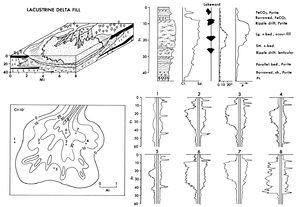
Diversion of a stream channel into one of the lake basins causes an appreciable increase in the sedimentation rate. Because of the infilling process, sedimentation rates increase within the lake sequence, and both grain size and thickness of laminations increase vertically upward. The process of infilling seems rapid if judged by present lakes where historic documentation indicates fill within only a few tens of years. Fisk (1952) has illustrated the phenomenal rate of growth of the Mississippi River delta into Grand Lake (Atchafalaya Basin) in recent years. In just over 20 years, more than 150 sq km of land surface formed within the lake area. The thickness of the delta fill varies, but ranges up to 7 and 8 m.
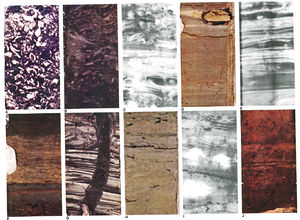
Figure 5 illustrates the major characteristics of the lacustrine delta-fill sequence. The upper left diagram is a schematic representation of a small distributary that has been diverted into a shallow freshwater lake. The schematic shows lateral relationships of the various facies, indicating that the bulk of the delta-fill forms a wedge of coarse clastics within an overall deposit consisting of fine-grained organic-rich clays from lacustrine and backswamp deposits. The upper right diagram of Figure 6 illustrates a typical vertical sequence, which normally displays a coarsening-upward trend. The lowermost units consist of lacustrine deposits. Quite often these lowermost units of the lacustrine delta consist of large accumulations or biomasses of shell (Figure 6A). Normally the shell deb is is encased in a matrix of fine-grained organic clays containing abundant pyrite inclusions. As the sedimentation rate within the delta increases, there is generally a decrease in the amount of coarse faunal remains. Organic activity, however, does not normally cease, and burrowing and abundant bioturbation of soft-bodied organisms can totally obliterate the primary structures (Figure 6B).
In most fill deposits, the burrows are sand filled due to the physiological processes of polychaete worms, which burrow through the muds, concentrating sands within their bodies and leaving behind essentially a sand- or silt-filled burrow. As the sedimentation rate continues to increase, laminations of thicker silt and sandy silt layers alternate with thinly laminated organic clays (Figure 6C). Burrowing persists upward within the deposits, but not to the point of masking primary stratification. Quite often the parallel-laminated clay deposits consist of extremely organic-rich clays, and leaf remains are common along the bedding planes. Color laminations and inclusions of iron carbonate nodules are often common within this part of the delta fill (Figure 6D).
Iron carbonate or siderite nodules often display smooth, elliptical forms along bedding planes of the slightly coarser deposits. Figure 6E is an X-ray radiograph of a core taken within the lower part of a silty clay delta fill. Parallel laminations are extremely well developed. Such laminations can be reminiscent of varve-like deposition. As the delta continues to prograde and infill the lake, sediments become appreciably coarser and depositional slopes become much steeper. Within the major part of the sand body itself, small-scale cross-laminations form the bulk of the stratification (Figure 6F). Scour and fill structures, occasional small slump structures, and load casts are common, and organic debris is generally prevalent. In the upper part of the delta-fill, large-scale cross-beds re very common, and it is not unusual in seismic sections to see essentially steep foreset beds dipping into the lake at angles of 10 to 12°.
When the delta completes its infilling process, swamp vegetation actively begins encroachment onto the filled lake surface, and root burrows extend down into the silty clays and sands often forming a distinctive horizon that caps the sand deposit (Figure 6G). Most often the root-filled burrows consist of clay and organic-rich infills. With the cessation of high depositional rates, organic clays begin to accumulate over lacustrine delta sands. Thin stringers of organic debris, both transported and in situ, commonly form organic-rich or near-black clays, which cap the sand body (Figure 6H). The organic-rich clays are deposited in a poorly drained, reducing backswamp environment and commonly contain abundant pyrite and iron carbonate inclusions (Figure 6I). The iron carbonate nodules begin to form almost immediately after deposition and often follow root burrows. As a result, nodules can display extremely knobby shapes.
With continued but slow accumulation, the deposit eventually fills to a level where the surface of the swamp is exposed to oxidizing conditions for several months during the year. Thus, oxidation begins to remove the organic content from the sediment. Movement of groundwater fluids through the sediments results in formations of numerous small, rounded pellets or iron oxide and calcium carbonate, commonly encrusting the root burrows. The clays within this unit often display a slight red coloration, illustrated in Figure 6.
The lower two diagrams in Figure 6 illustrate a typical isopach map of a small lake delta infill and variations in log response through such a deposit. The isopach tends to indicate a wedge of coarse clastic sediments sandwiched between lower freshwater organic lacustrine deposits and overlying swamp and marsh deposits. Most often the logs will document the coarsening-upward sequence of this delta fill. Within the sand body, dip angles are often quite high, reaching 10 to 15°, and result primarily from the foresets of the rapidly prograding lacustrine delta. Often, resistivity kicks are extremely common within such a setting and are responses to lignite, coal, and iron-rich seams which form within these essentially red bed deposits. The sand body itself normally displays a graded base; however, in some areas, generally near breaks in the riverbank, thick, sharp-based sands can often accumulate immediately within the region of the actual crevassing.
Further reading
Literature on braided-channel deposits.
- Allen, J. R. L., 1965a, Fining upward cycles in alluvial succession: Liverpool, Manchester, Geol. Jour., v. 4, p. 229-246.
- Allen, J. R. L., 1965b, A review of the origin and characteristics of Recent alluvial sediments: Sedimentology, v. 5, p. 88-191.
- Are, H. T., 1963, The braided stream depositional environment: PhD dissertation, Univ. Wyoming, 205 p.
- Cant, D. J., and W. G. Walker, 1976, Development of a braided-fluvial facies model for the Devonian Battery Point Sandstone: Can. Jour. Earth Sci., v. 13, p. 102-119.
- Chien, N., 1961, The braided stream of the lower Yellow River: Sci. Sinica, Peking, v. 10, p. 734-754.
- Clapp, F. G., 1922, The Hwang Ho, Yellow River: Geogr. Review, v. 12, p. 1-18.
- Coleman, J. M., 1969, Brahmaputra River: channel processes and sedimentation: Sedimentary Geology, v. 3, p. 129-239.
- Collinson, J. D. 1970, Bedforms in the Tana River, Norway: Geog. Ann., Stockholm, v. 52, p. 31-56
- Doeglas, D. J., 1962, The structure of sedimentary deposits of braided rivers: Sedimentology, v. 1, p. 167-190.
- Fahnestock, R. K., 1963, Morphology and hydrology of a braided stream: U.S. Geol. Survey Prof. Paper 422A, p. 1-70.
- Fahnestock, R. K., and W. C. Bradley, 1973, Knik and Matanuska Rivers, Alaska: a contrast in braiding: in M. Morisawa, ed., Fluvial geomorphology: Publications in Geomorphology, State Univ. of New York, Binghampton, 314 p.
- Krigstrom, A., 1962, Geomorphological studies of sandur plains and their braided rivers in Iceland: Geog. Ann., no. 44, p. 328-346.
- Leopold, L. B., and M. G. Wolman, 1957, River channel patterns: braided, meandering, and straight: U.S. Geol. Survey Prof. Paper 282-B, p. 39-85.
- NEDECO, 1959, River studies and recommendations on improvement of Niger and Benue: Amsterdam, North Holland Pub. Co., 1000 p.
- Rust, B. R., 1972, Structure and process in a braided river: Sedimentology, v. 18, p. 221-245.
- Schumm, S. A., 1972, River morphology: Dowden, Hutchinson and Ross, Stroudsburg, Pa., 448 p.
- Shelton, J. W., and R. L. Noble, 1974, Depositional features of braided-meandering stream: AAPG Bulletin, v. 58, no. 4, p. 742-752.
- Smith, N. D., 1970, The braided stream depositional environment: Comparison of the Platte River with some Silurian clastic rocks, north-central Appalachians: Geol. Soc. America Bull., v. 81, p. 2993-3014.
- Visher, G. S., 1965, Fluvial processes interpreted from ancient and recent fluvial deposits: in G. V. Middleton, ed., Primary sedimentary structures and their hydrodynamic interpretation: SEPM Spec. Pub. no. 12, p. 133-148.
- Visher, G. S., 1972, Physical characteristics of fluvial deposits: in J. K. Rigby and W. K. Hamblin, eds., Recognition of ancient sedimentary environments: SEPM Spec. Pub. 16, p. 84-97.
- Williams, P. F., and B. R. Rust, 1969, The sedimentology of a braided river: Jour. Sed., Petrology, v. 39, p. 649-679.
- Wright, M. D., 1959, The formation of cross-bedding by a meandering or braided stream: Jour. Sed. Petrology, v. 29, p. 610-615.
Literature on meandering rivers and their characteristics.
- Allen, J. R. L., 1965a, Fining upward cycles in alluvial succession: Liverpool, Manchester, Geol. Jour., v. 4, p. 229-246.
- Bernard, H. A., et al, 1970, Brazos alluvial plain environment: Texas Bureau of Econ. Geol. Guidebook No. 11.
- Bluck, B. J., 1971, Sedimentation in the meandering river Endrick: Scot. Jour. Geol., v. 7, p. 93-138.
- Fisher, W. L., and L. F. Brown, 1972, Clastic depositional systems--a genetic approach to facies analysis: Bur. of Econ. Geol., Univ. of Texas at Austin, 211 p.
- Fisk, H. N., 1944, Geological investigation of the alluvial valley of the lower Mississippi River: U.S. Army Corps of Engr., Mississippi River Commission, Vicksburg, Miss.
- Frazier, D. E., and A. Osanik, 1961, Point-bar deposits, Old River Locksite, Louisiana: Trans. Gulf Coast Assoc. Geol. Soc., v. 11, p. 121-137.
- Harms, J. C., D. B. MacKenzie, and D. G. McCubbin, 1963, Stratification in modern sands of the Red River, Louisiana: Jour. Geology, v. 71, p. 556-580.
- Jackson, R. G., 1975, A depositional model of point bars in the lower Wabash River meander belt: PhD thesis, Illinois Univ., Urbana, 269 p.
- Lewin, J., 1976, Initiation of bedforms and meanders in coarse-grained sediment: Geol. Soc. America Bull., v. 87, p. 281-285.
- McGowen, J. H., and L. E. Garner, 1970, Physiographic features and stratification types of coarse-grained point bars: modern and ancient examples: Sedimentology, v. 14, p. 77-111.
- Steinmetz, R., 1967, Depositional history, primary sedimentary structures, cross bed dips, and grain size of an Arkansas River point bar at Wekiwa, Oklahoma: Rept. F67-G-3, Amoco Production Co.
- Sundborg, A., 1956, The River Klaralven: a study of fluvial processes: Geog. Ann., v. 38, p. 125-136.
Literature on lacustrine deposits.
- Axelson, V., 1967, The Laitaure Delta, a study of deltaic morphology and processes: Geog. Ann., Stockholm, v. 49, p. 1-127.
- Coleman, J. M., 1966, Ecological changes in a massive freshwater clay sequence: Gulf Coast Assoc. Geol. Soc. Trans., v. 16, p. 159-174.
- Coleman, J. M., and C. L. Ho, 1968, Early diagenesis and compaction in clays: Proc. Symp. on Abnormal Subsurface Pressures, Louisiana State Univ., Baton Rouge, p. 23-50.
- Coleman, J. M., and S. M. Gagliano, 1964, Cyclic sedimentation in the Mississippi River deltaic plain: Gulf Coast Assoc. Geol. Socs. Trans., v. 14, p. 67-80.
- Bradley, W. H., 1964, Geology of Green River Formation and associated Eocene rocks in southwestern Wyoming and adjacent parts of Colorado and Utah: U. S. Geol. Survey Prof. Paper 496A, 86 p.
- Fisk, H. N., 1952, Geological investigation of the Atchafalaya Basin and problems of Mississippi River diversion: U.S. Army Corps of Engineers, Mississippi River Commission, Vicksburg, Miss., p. 1-145.
- Muller, G., 1971, Sediments of Lake Constance: Guidebook, 8th Inter. Sedimentology Cong., p. 237-252.
- Reeves, C. C., Jr., 1968, Introduction to paleolimnology: in Developments in sedimentology, v. II: Amsterdam, Elsevier, 228 p.
- Twenhofel, W. H., 1950, Principles of sedimentation: New York, McGraw-Hill, 673 p.
- van Houton, F. B., 1964, Cyclic lacustrine sedimentation, Upper Triassic Lockatong Formation: in D. F. Merriam, ed., Symposium on cyclic sedimentation: Kansas Geol. Bull. 169, p. 497-531.
See also
References
- ↑ Coleman, J. M., 1969, Brahmaputra River: channel processes and sedimentation: Sedimentary Geology, v. 3, p. 129-239.
- ↑ Reineck, H. E., and I. B. Singh, 1967, Primary sedimentary structures in the Recent sediments of the Jade, North Sea: Marine Geol., v. 5, p. 227-235.
- ↑ 3.0 3.1 3.2 3.3 3.4 3.5 Coleman, J. M., and D. B. Prior, 1981, Deltaic environments of deposition, in P. A. Scholle and D. Spearing, eds., Sandstone depositional environments: AAPG Memoir 31, p. 139-178.